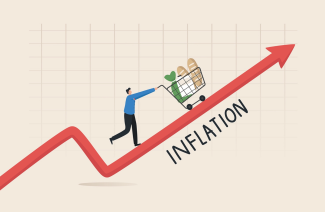
Types of Inflation That Should Know About
Types of Inflation That Should Know About
As prices rise and living expenses rise, many wonder how to protect their financial future from inflation. Understanding the various types of inflation — demand-pull, cost-push, and built-in — and how they affect purchasing power will allow you to strategize successfully.
To ensure the economy runs smoothly, central banks such as the Federal Reserve in the United States work hard to keep inflation and deflation at bay. Central banks aim to keep inflation under control by influencing interest rates and using other monetary policy tools, which are critical strategies for managing the nation's money supply and affecting the economy's overall health. They typically set an inflation target that is considered healthy for economic growth.
At its most fundamental, inflation is a general increase in prices throughout the economy, which we all understand. After all, who hasn't reminisced about past low rentals were? Who has not noticed that the costs of everything from milk to movie tickets are rising? In this blog post, we will look at the main types of inflation.
Demand-Pull Inflation
Demand-pull inflation outlines how increased demand for products and services causes prices to rise. Consumers are more able to pay higher prices when something is in short supply.
Are you still paying for aircraft tickets for a holiday despite prices being far higher than usual? That's an excellent illustration of demand-pull inflation. The United States is witnessing demand-pull inflation as salaries rise and Americans have a reasonable amount of money in their savings accounts. This sort of inflation can cause increased pricing for products and services, lowering your purchasing power. This could reduce your savings because your salary may need to catch up with escalating expenditures.
Cost-Push Inflation
Cost-push inflation occurs when production costs such as raw materials and wages rise, resulting in higher consumer prices. This inflationary pressure can be caused by various circumstances, including supply chain interruptions and price increases in vital commodities.
One historical example is the 1970s oil price shock, which significantly increased the cost of production for numerous goods and services, resulting in widespread inflation. Cost-push inflation frequently occurs when demand-pull inflation is high. When raw material costs rise, businesses must raise their pricing, regardless of demand.
Price increases have put manufacturers in a difficult position. They have two options: accept rising costs and maintain the same prices or try to maintain the same profit margins.
Built-in Inflation
Built-in inflation is a term used to describe the inflation rate already built into a fiat currency's base unit. When the value of a currency rises year after year, it outpaces inflation.
Built-in inflation, also known as wage-price inflation, is a self-sustaining type of inflation in which workers demand greater wages to keep up with rising living costs. Having as a result higher prices for goods and services as firms pass on these costs. This dynamic has the potential to produce a feedback loop in which salary rises cause price increases, which in turn lead to additional wage demands.
Policymakers or corporations can combat built-in inflation by enacting policies that limit wage growth through productivity gains or investing in efficiency-enhancing technologies.
Final Notes
Inflation can take numerous forms, ranging from historically catastrophic episodes of hyperinflation and stagflation to small five-cent and ten-cent increases that go unnoticed. Economists from Keynesian and monetarist schools disagree on the core causes of inflation, highlighting that inflation is a much more complex issue than one may first believe.
In anticipation of inflation, people and organizations can use a variety of tactics to protect their financial positions. In reaction to demand-pull inflation, one may consider investing in assets that are anticipated to gain or keep their value over time, such as real estate or dividend-paying equities.
When preparing for cost-push inflation, broadening one's investment portfolio to include commodities like gold or oil might help hedge against growing production costs. Furthermore, organizations should improve operational efficiency to reduce the impact of rising expenses. Individuals may seek jobs in industries less affected by inflationary pressures or improve their education and abilities to earn more excellent wages.
